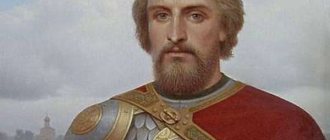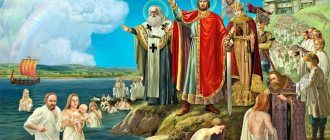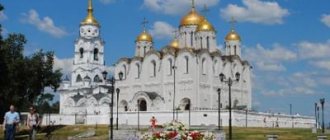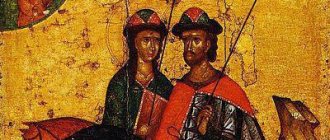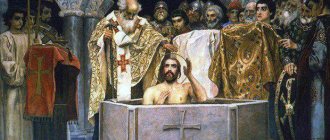The first Russian saints were princes Boris and Gleb. They were canonized in 1072, less than 100 years after the adoption of Christianity. The first Russian saints became the heavenly patrons of the Russian land, as recalled by several monasteries, the city of Borisoglebsk, the village of Boris-Gleb and several villages with the name Borisogleb.
Origin
They were both sons of Prince Vladimir the Saint. The date of their birth is unknown, probably around 990. According to the chronicles, Boris’s mother was either Anna of Byzantium or a “Bulgarian”. Consequently, if we remember that after 988 Prince Vladimir did not enter into new marriages, then the date of birth of Boris could be 987; during the pagan period of his life he could have had a wife of Bulgarian origin.
Rice. 1. The first Russian saints.
He received from his father an appanage throne in the city of Rostov, remote from Kyiv, on the territory of the modern Yaroslavl region. At the beginning of the 11th century, this was a distant outskirts of the Old Russian state, since Moscow, Tver, Kostroma and Vladimir-on-Klyazma did not yet exist.
His brother Gleb was also born to either Anna or a wife of Bulgarian origin. Most likely they were twins. From his father he received an inheritance in Murom. This city, like Rostov, was the outskirts of Russian lands. Around it lived the Finno-Ugric tribes of Meshchera and Murom, and to the east was the state of Volga Bulgaria. Nothing is known about the activities of the princes before 1015.
They became saints under worldly names, and their baptismal names were Roman and David. However, by the end of the 10th century the name Boris ceased to be pagan; for example, one of the outstanding Bulgarian kings was called that way.
Rice. 2. Saints Boris and Gleb.
Holy Fools
- this is the name of the new order of holiness, which has been included in the Russian Church since the beginning of the 14th century. “For Christ’s sake, a holy fool” or “blessed” is a person who has taken on the guise of madness for the sake of rejecting the values of worldly life. With their feat of feigned madness or immorality, they revealed the incompatibility of such concepts as Christian truth and common sense. Almost all holy fools are credited with the gift of prophecy, which is given to them as a reward for their contempt for human reason. According to contemporaries, the ancient Russian holy fools walked naked, with loose hair and an iron chain around their necks. Novgorod became the birthplace of Russian foolishness. It was from Novgorod that Procopius of Ustyug (14th century), Nikola Kochanov (14th century), and Mikhail Klopsky (15th century) came from. The series of Moscow holy fools begins with St. Maxim (15th century), and the most famous among them was St. Basil the Blessed (16th century). In the 16th century Foolishness became a form of prophetic (in the Hebrew sense) service, combined with extreme asceticism and ridicule of the world. In this era, when the church hierarchy found itself practically deprived of its right to mourn (intercession) for those unjustly convicted, the feat of holy fools acquired social and even political meaning: denunciation of the powerful of this world became an integral part of holy foolishness. It is the holy fool, who cannot be deprived of his voice, who now acts as the only champion of Christ’s truth. From the end of the 16th century. The authorities are beginning to become increasingly suspicious of holy fools. In the 18th century The Synod prohibited the canonization of the blessed. The last saints of this order of holiness were Blessed Xenia of St. Petersburg (18th–19th centuries) and Blessed Nikolai Rynin (19th century), canonized in the 20th century.
The tragic fate of Boris and Gleb
In 1015, Prince Vladimir Svyatoslavich was ill and summoned Prince Boris from Rostov. He entrusted him with a campaign against the Pechenegs. Boris did not find the enemy, so he went back to Kyiv. Along the way, he stopped at the Alta River, which is located in the southeast of the modern Kyiv region. During the campaign, Prince Vladimir died and the throne was taken by Boris's half-brother, Prince Svyatopolk. He decided to get rid of his brother, considering him a competitor for the throne in Kyiv. Assassins were sent to Boris, they pierced him with spears and stabbed him in the heart with a sword. Prince Gleb was the next to die. Svyatopolk summoned him to Kyiv. On the way, Gleb made a stop near Smolensk, where the killers found him.
Initially, Boris was buried in Vyshgorod, and Gleb near Smolensk. 4 years after the strife between Svyatopolk and Yaroslav, in 1019, his body was transferred to Vyshgorod.
They are saints not only for the Russian Orthodox Church, but also for the Catholic Church. In her lists of saints they are known as Roman the Russian and David the Polish. The date of their canonization in Rus' is still controversial, between 1020 and 1115.
Rice. 3. Boris and Gleb saints.
Orthodox Life
July 12, old style (July 25, New Style) is the day of remembrance of the holy Varangian martyrs Theodore and John, who gave their lives for the faith of Christ. What do they teach us – Christians of the 21st century?
Sergey Efoshkin. The first Russian martyrs Fyodor and John before their death
Today, modern myth-makers in their writings are trying to present pre-Christian Rus' as some wondrous and beautiful legendary country similar to Tolkien’s Middle-earth. They are trying to impose a myth on society that there lived wise and beautiful geniuses-demigods who had highly developed technology and social structure. And Slavic pagan magic is the remnant of these ancient Hyperborean-Aryan-Slavic technologies. Then “wild” “bloodthirsty” Christians came to Rus' and enslaved this ancient “bright” and “beautiful” culture.
Is it so? Let's try to figure it out.
The main “sacred” text of modern neo-pagans is the so-called “Book of Veles,” which was allegedly written on tablets in the ancient Slavic language and told about the “beautiful” life of pre-Christian Rus'. Today, most learned historians are one hundred percent sure that this is a falsification, and a very crude one at that. The book was written in the 19th century and primitively imitated the Proto-Slavic language. Today it is widely used in their rituals and pseudo-arguments by neo-pagans and Satanists.
But representatives of these sects do not need real historical science. They have enough imagination and fiction, which can combine many religious and cultural archetypes from the Scandinavian epic to Buddhist and Hindu beliefs. Moreover, pseudo-historians borrow and mix at will the traditions of other peoples, completely without taking into account the history of religion and the mentality of nations. They make up their own neologisms that do not exist in reality.
So, for example, when I was still working as a journalist, I was at a press conference with one such neo-pagan pseudo-historian. He informed the public that the ancient Greeks descended from Ukrainians, and Trypillian glechiki are warm to the touch and resemble icons. Among other things, the pseudoscientist said that the Trypillians created a globalistic culture with the highest level of civilization.
How did things really stand in pagan Rus' - in this fusion of related Slavic tribes, which, meanwhile, very often fought with each other?
Quote from the work of the Monk Nestor the Chronicler “The Tale of Bygone Years”: “And the Drevlyans lived according to bestial customs, lived like bestials: they killed each other, ate everything unclean, and they did not have marriages, but they kidnapped maidens near the water (an allusion to Ivan Kupala - Author ). And the Radimichi, Vyatichi and northerners had a common custom: they lived in the forest, like all animals, ate everything unclean and dishonored themselves in front of their fathers and daughters-in-law, and they did not have marriages, but they organized games between the villages, and gathered at these games, at dances and all sorts of demonic songs, and here they kidnapped their wives in agreement with them; they had two and three wives.”
There is a well-known story about how in the second half of the ninth century the northern Slavic tribes Chud, Ilmen Slovenes, Krivichi and the rest could not put out the many-year fire of internecine war among themselves, and in order to restore peace, they invited a landless Scandinavian (according to another Danish version) king ( Prince) Rurik (Rorik) with his squad, who earned his living by being a hired soldier in various early feudal internecine conflicts. When Rurik came to the North Russian land, the Slavic elders brought a grateful sacrifice to the god Veles. They drugged several beautiful girls of the tribe, chose the most “worthy” of them and drowned her in the lake where, according to their beliefs, Veles lived.
These are the truth and real facts.
We also know the lives of the holy martyrs Theodore Varangian and his son John, who allegedly suffered on July 12, 978. The fact is that in Rus' at that time there had been a religious and social oscillation between Christianity and paganism among the people for many years. But already under Oleg the Prophet, who killed the above-mentioned princes, a pagan reaction sets in. Under Igor Rurikovich and his wife, the holy Equal-to-the-Apostles Grand Duchess Olga, favorable times came again for Christianity, but already her son Svyatoslav destroyed churches and favored the pagans. His work was continued at the beginning of his reign by the holy Equal-to-the-Apostles Grand Duke Vladimir. After the death of Svyatoslav in 970, his eldest son Yaropolk came to power in Kyiv. According to many historians, he professed Christianity. The time of his reign became a very favorable time for Orthodoxy. In 978, Vladimir, sitting on the table of Veliky Novgorod, incited by pagan priests and warriors, went on a campaign against Kyiv. This war had a religious overtones of the struggle of Russian-Varangian paganism against the nascent Kievan Christianity.
Vladimir won. Yaropolk was treacherously stabbed to death with the swords of the Varangians. And Vladimir decided to make grateful human sacrifices to the god of war Perun in pomp and pomp. The priests cast lots. And the choice (perhaps not without priestly intent) fell on the young Christian John, the son of the Varangian warrior Theodore. Father and son converted to Orthodoxy in Byzantium, where Saint Theodore served in the army.
When pagan priests came to Theodore with a call to sacrifice John, whom “the gods chose for themselves, let us sacrifice him to them,” he replied: “These are not gods, but a tree. Today it exists, but tomorrow it will rot. They do not eat, drink or speak, but are made of wood by human hands. God is One, the Greeks serve and worship Him. He created the heavens and the earth, the stars and the moon, the sun and man, and destined him to live on earth. What did these gods do? They themselves are created. I will not give my son to the demons.”
This was a direct challenge from the Christian to the pagans, who were furious with him. They surrounded Theodore's house with a tax, but could not take the brave Christian Varangians by storm; Theodore and John repelled all attacks. Then the pagans cut down the wooden foundation of the house, and it collapsed on the martyrs. So they were killed.
Already in the era of St. Nestor the Chronicler in the 11th century, the first martyrs of Rus' were canonized. At the site of their martyrdom, a little later, their recent persecutor, Saint Prince Vladimir, erected the Tithe Church of the Assumption of the Blessed Virgin Mary, consecrated on May 12, 996.
By the providence of God, their murder became the last of the bloody pagan victims in Kyiv and the first co-crucifixion with Christ among the Slavs. They were called the first “Russian citizens of the heavenly city” by the writer of the Kiev-Pechersk Patericon, Bishop Simon, Saint of Suzdal († 1226; commemorated May 10). The last of the bloody pagan victims in Kyiv became the first holy Christian sacrifice - co-crucifixion with Christ. The path “from the Varangians to the Greeks” became for Rus' the path from paganism to Orthodoxy, from darkness to light.
This was the last surge of paganism. A new life-giving Christian era was beginning for Rus'. And if it weren’t for her, then, it seems to me, the Slavs would no longer exist. They would destroy themselves.
Faith in Christ and love for one's neighbor became the basis for the future life of the Eastern Slavs. And this became the first step from darkness to light - from indulging one’s passions to demonstrating true love for God and neighbor.
Holy martyrs Theodore and John, pray to God for us!
Priest Andrey Chizhenko
